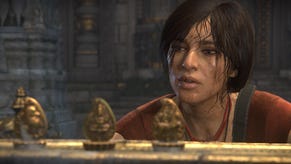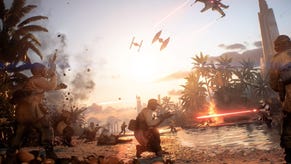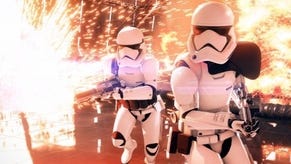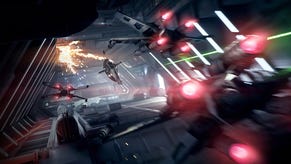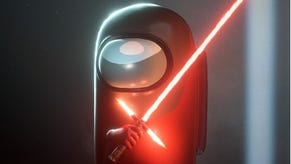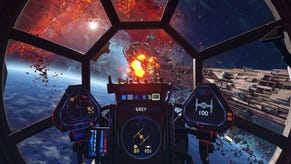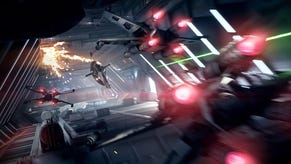How Star Wars Battlefront 2's stunning tech scales across consoles
Digital Foundry breaks down the beautiful beta on PS4, Pro and Xbox One.
DICE's Frostbite engine kicked off the console generation with Battlefield 4, and the technology has evolved considerably over the last four years. Star Wars Battlefront 2 may well be its most spectacular outing yet. Importing and enhancing many of the new features from last year's Battlefield 1, our impression of the recent 2 beta is that we're not simply looking at newer maps, weapons, and characters, but a clear visual upgrade that brings us even closer to the definitive Star Wars videogame experience. It's all about authenticity - Frostbite's feature set is a terrific match for the Star Wars aesthetic.
Take the battle set on Naboo. The capital city shows a level of detail significantly beyond that of the first Battlefront. The beautiful buildings are rendered with complex geometry and plenty of intricate detail, packed with combatants via the 40-player Galactic Assault mode. Move inside the palace and DICE's exemplary use of physically-based rendering and photogrammetry (with surface properties scanned in from real-life materials) creates a distinct look to the presentation that is pure Star Wars.
This level of detail is also evident on Takadana, a planet from The Force Awakens where resistance forces battle against a ground assault by the First Order. The forests surrounding Maz's castle are alive with particle physics in the form of debris and leaves blowing in the wind, while the general level of detail on offer is superb, on par if not better than the most dense maps from the first Battlefront. Lighting, shadows, and post-processing are also expanded upon too, with heavy use of film grain, chromatic aberration, and lens distortion - though perhaps some aspects here are layered a little heavily.
Happily, while graphical complexity has increased, DICE has also managed to improve console image quality too. The first Battlefront runs at a fixed 900p on PS4 and 720p on Xbox One, while dynamic resolution scaling is in play on its sequel, with pixel counts raised and lowered according to rendering load. The net result is that for the majority of the game's duration, Battlefront 2 also runs at a higher resolution than its predecessor - a great endorsement of the benefits of this technique.
On PS4 we're looking at between 972p to a full 1080p, but outside of more demanding scenes the game sticks very closely to its full HD target, so as a result, image quality is noticeably cleaner and clearer. Additional softness only starts to creep in as the engine is put under load in more complex scenes, but drops in resolution rarely last for long. It's a similar story for Xbox One, which fluctuates between 792p to around 1000p, usually hovering around the 900p mark for extended periods. As expected, PS4 tends to deliver a more consistent, sharper experience, but the use of temporal anti-aliasing ensures that scaling artefacts are rarely an issue on either platform - both appear smooth, though soft at times.
Meanwhile, PS4 Pro resolution increases to a maximum of 1440p, though 1296p seems to be the most common result during regular gameplay. It's not the best upgrade in resolution for those using a 4K screen, but the game does support down-sampling, so image quality on a 1080p screen is improved over base PS4. Resolution appears more consistent, and the temporal AA is also boosted by the extra coverage down-sampling provides.
On top of that, there's evidence of settings tweaks to the engine, giving an improved look overall. In short, the sense we get from this initial look is that the PS4 Pro game features a balance of visual boosts and resolution, similar to Battlefield 1. The difference with last year's DICE epic is that checkerboarding seems to have been removed.
Our only bugbear with the game's visual presentation based on what we've seen so far is that the heavy use of post-processing often yields a softer presentation than we'd expect to see. The film grain suits the look of the game, but chromatic aberration and lens distortion can feel out of place. Thankfully, DICE's lighting lead on the project has stated that these elements are set for be tweaked, so it'll be interesting to see how the developer chooses to rebalance the post-processing pipeline for the final release.
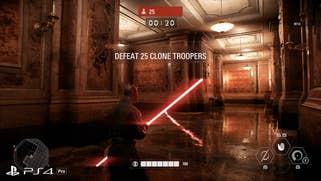

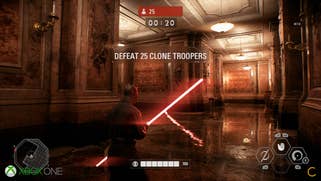
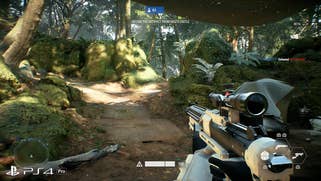

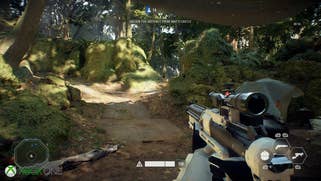
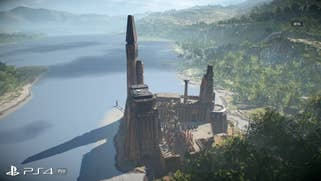
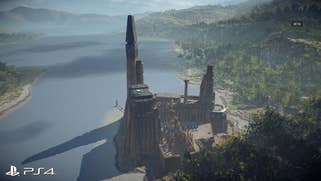
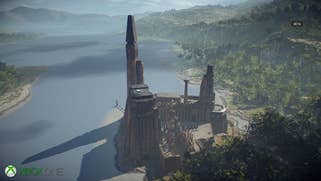

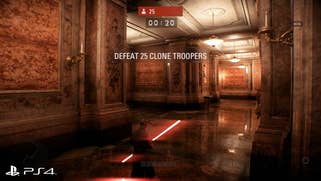

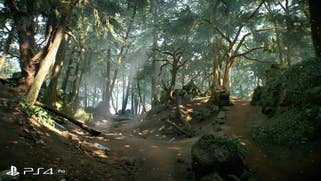

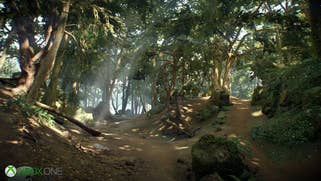
Beyond resolution, the visuals are subtly tweaked across each console. Comparison points in the beta are limited, but the Pro benefits from improved ambient occlusion, higher quality light-shafts and slightly more complex use of tessellation across some scenery, such as the rocky hillsides found on Takodana. Meanwhile, base PS4 offers up slightly higher resolution shadows and reflections over Xbox One, along with a refinement in tessellated surfaces. Curiously, asset streaming is faster on base PS4 than on the other consoles. Perhaps this is down to individual hard drive tolerances, as all machines are equipped with 5400 RPM drives. Or it could be down to this being unfinished beta code, and that not all aspects of the game are fully optimised yet. Generally though, there's a sense that the Battlefront 2 experience features more refinement as you venture up the console power ladder, despite some occasional anomalies.
Battlefront 2 delivers a visual boost over the original game then, while also tweaking the experience for each platform. But what does this mean for performance? With higher resolutions and more complex graphics in play, it's clear that the current version of the beta is hitting base PS4 and Xbox One harder than the original game. Whereas the original managed to deliver a practically solid 60fps on PS4, and only minor dips on Xbox One, this sequel struggles at times to provide a stable level of performance. The massive Galactic Assault modes often drop into the mid to low 40s across both consoles, with frame-rates hit a little harder on Xbox One. It's the more open areas in heavy action scenes that tend impact upon performance here, with particle effects and large numbers of players taxing GPU bandwidth and CPU processing power.
Move into less stressful situations, such as the Naboo palace interior, or the strike mission set on Takodana, and frame-rates come much closer to hitting 60fps. It's not perfect, but the dips are less noticeable than the Galactic Assault mode, and the game spends more time at that buttery smooth, flawless updat rate. Out of the base consoles, the PS4 comes out slightly ahead, with fewer drops in performance when the engine is under load, with matches feeling a little more consistent in terms of smoothness. In comparison, the PS4 Pro generally comes very close to hitting 60fps, and performance there is much to closer to the original game running on Xbox One.
Of course, it's worth bearing in mind that this is a beta build we're looking at - unfinished code that hasn't been fully optimised. So, it's expected that performance and other aspects of the visuals may be improved for the final game. In fact, DICE has a track record in this area. With the first Battlefront, performance fell short in earlier builds, but delivered a nigh-on locked 60fps in the final release.
Nobody can bet against DICE when it comes to optimisation so it stands to reason that we could see a similar improvement with Battlefront 2 as well. That said, the visual upgrades in this sequel are pushing the consoles harder than before, so whether the taxing Galactic Assault stages can achieve the same silky-smooth consistency remains to be seen. It will certainly be interesting to see what Xbox One X brings to the table in this regard, especially if the visual feature set is further increased over the current consoles.
But for now, based on the strength of the beta, Battlefront 2 is shaping up nicely. While performance could be more consistent (and hopefully will be in final code) the look and feel of the game is otherwise excellent across all platforms. The new locations and space battles look spectacular, while the familiar sound effects and John Williams score really help to deliver an authentic Star Wars feel throughout the game. The multiplayer aspect holds up well too, with reliable matchmaking and mostly stable in-game netcode.
But having absorbed the beta over the last few days, it's the single-player campaign that remains the great unknown. Set from the perspective of an Imperial Stormtrooper, this looks to be a unique take on the Star Wars story. And on a visual level, there's the potential for memorable set-pieces alongside another boost to graphical complexity too - elements that should take full advantage of the Frostbite engine. The beta has been a visual treat - we're fascinated to see if the single-player mode can trump it.



